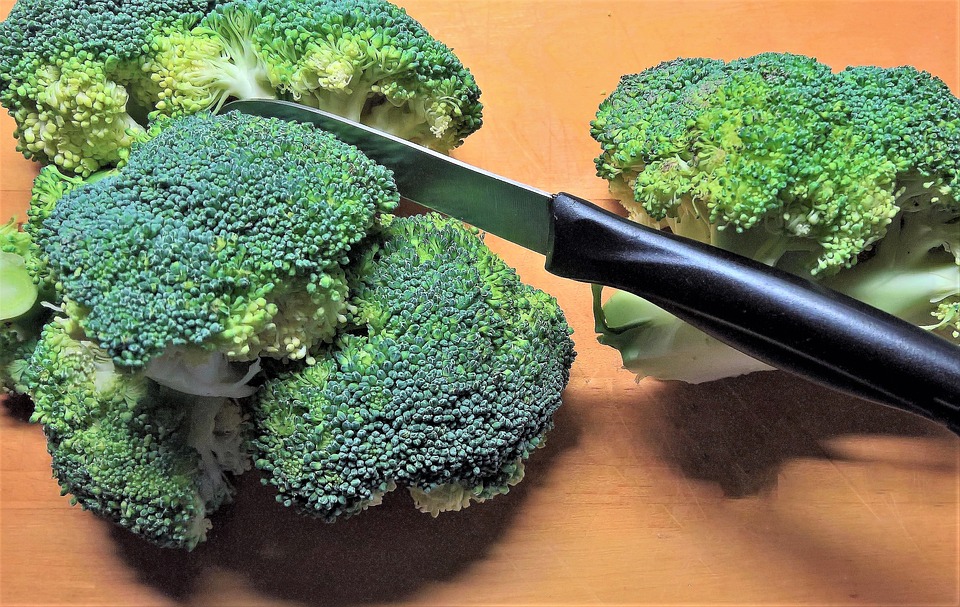If you are looking for a healthy and simple meal, you can try cooking broccoli florets. Not only does it save you the trouble of preparing a dish from scratch, but it also keeps the nutritional value of the vegetable intact. However, to freeze broccoli florets, you must first blanch and freeze the vegetables. This ensures that the color and texture will not be affected, and the nutrients will remain uncontaminated.
Use this advice on how to freeze broccoli if you have a surplus of vegetables in your home. Smoothies are one usage for frozen florets, among many others.

What is Broccoli Floret?
The tree-like broccoli florets are joined to smaller stems, which are subsequently joined to a bigger stalk. These stalks have a crisp feel and need to cook for a little longer than the florets. If you’re using both, it’s best to chop and fry the stalks first before moving on to the florets.
Vitamins C and K are very abundant in broccoli. You can eat it cooked or uncooked. Boiling reduces the content of its specific sulfur-containing glucosinolate molecules, isothiocyanates, and sulforaphane, whereas steaming, microwaving, or stir-frying better preserves these components.
How to Freeze Broccoli Florets?
Step One
Breaking broccoli into florets is the first stage in the freezing process. Around 3 1/2 cups of florets can be obtained from one large head.
Step Two
After that, heat some water in a pot so that you may gently blanch the broccoli. It’s crucial to blanch it at a low temperature to retain the sulforaphane, one of its cancer-fighting components.
Step Three
Add the florets to the pot once the water has reached a simmer. For three minutes, let them simmer.
Step Four
Transfer the blanched florets to a dish of ice and water using a slotted spoon. This will stop the cooking and guarantee that your florets maintain their lovely green color.
Step Five
Next, move the florets from the water bath to a baking sheet covered with parchment paper using a slotted spoon. Make sure they don’t get in contact with one another. By doing this, you can ensure that your broccoli freezes in separate pieces rather than clumps.
Step Six
Freeze your baking sheet for at least 6 hours and up to 24 hours. Afterward, take the baking sheet off the oven and put the frozen florets in a zip-top bag. Store for up to several months in the freezer.
How to Thaw Frozen Broccoli Florets?
In the Microwave
Broccoli florets that have been frozen can be thawed in the microwave if pressed for time. To prevent cooking the food in hot patches while the rest remains frozen, Bruning advises utilizing the defrost or low-power mode. To ensure that the veggie thaws evenly without overcooking it, Bruning advises stopping the microwave and stirring it every 30 to 60 seconds.
In the Refrigerator
Frozen broccoli florets can be defrosted in the refrigerator, as with most items. Jen Bruning, MS RDM LDN, a representative for the Academy of Nutrition and Dietetics, advises placing the packed Broccoli florets in a container before thawing to prevent condensation from dripping into other meals. She points out that since frozen broccoli florets often cook at a lower temperature than other foods, they can thaw on the refrigerator’s upper shelves as opposed to meat, which should be kept there.
How to Store Broccoli?
Broccoli is at home in your cold refrigerator as a resilient, cool-weather vegetable. In reality, it is frequently frozen until it reaches the store shelves. It dislikes dry refrigerator air, a tight wrapper, and an abundance of wetness. As a result, you must properly prepare and store it.
Most fruits and vegetables, particularly bananas, emit ethylene gas while they sit. The ethylene will be contained if you put your broccoli in a bag with a tight seal, hastening the breakdown of the produce. However, if you leave your broccoli uncovered, the dry refrigerator air will cause it to wilt soon and become floppy. So keep it loosely wrapped in an open plastic bag to allow it to “breathe.”
Dry out your bunch as much as possible before storage if it is wet from the supermarket mist. Put the broccoli in the crisper drawer of your refrigerator, away from fruits and vegetables like apples that release a lot of ethylene gas. If the crisper is full, place it on a shelf near the rear of the refrigerator. To help drain the extra moisture before bagging the head, you may even wrap the entire thing in a layer of paper towels.
Your broccoli can stay in the fridge for up to a week and possibly even a few days longer if it is properly wrapped. But you may also freeze broccoli to enjoy if you overbought it or can’t use it before then. This recipe for melting blanched broccoli spread is ideal for past-its-prime broccoli if you haven’t frozen it in time.
How to Choose Perfect Broccoli?
Pick a head of broccoli that has dense, dark-green buds that are tightly closed. The stalks shouldn’t have any browning or yellowing and should be green and healthy-looking. Look at the stem end; it shouldn’t be dried up or shriveled and appear as though it was cut recently.
Since broccoli is truly a flower, a small amount of yellow blossoming at the tips is OK as long as the other florets appear vivid, fresh, and green. But stay away from florets that appear to be wilting and have a lot of yellowing; this indicates that the broccoli is past its peak. A less-than-fresh bunch also has mushy areas and a rotting odor.
Is Yellow Broccoli Bad?
Yellow broccoli isn’t necessarily horrible, but at best, it’ll taste mediocre, and at worst, it’ll taste awful. In other words, although your broccoli may still be fine to eat if it has turned yellow, its quality won’t be as high as that of fresh, green broccoli.
The growth of additional pigments and the loss of chlorophyll are both signs of the broccoli yellowing as it ages. I should state that these are undesirable pigments.
According to numerous sources, the yellowing of the florets signals the end of broccoli’s shelf life. Therefore, it isn’t good if the entire head of broccoli is yellow or has even begun to brown.
However, broccoli is unquestionably safe if the florets are predominantly green with a few teeny-tiny patches of fading here and there. If there aren’t many yellowing ones, you can trim them or leave them alone.
To cut a long tale short, you should probably throw out that broccoli if the entire head or the majority of it is yellow. However, you can still use that broccoli head if only a little portion turns yellow and the remainder is still attractively green.
How to Identify Whether Broccoli Florets are Bad?
If your broccoli is limp, slimy, moldy, or shows other outward signs of degradation, throw it away. If the vegetable has become yellow, brown, or smells off, throw it away. Likewise, throw away any cooked broccoli that has been kept for more than four days.
That is basic broccoli rotting.
Let’s now explore each point’s specifics.
Broccoli that is limp, soft, or slimy
Fresh broccoli has florets that are a vivid green and firm to the touch. But when the vegetable ages, part of its water is lost, and this is when broccoli softens and limps.
Of course, there is a wide range here, and broccoli doesn’t turn limp after a couple of days of being firm. Instead, depending on storage circumstances, the process requires at least a few days.
When broccoli is left at room temperature, it loses moisture significantly more quickly.)
Therefore, if your broccoli is just a bit softer than when it was fresh, you can still utilize it. It’s not good, though, if the entire item is wilted and very soft.
Sometimes, some vegetable sections lose water more quickly than others. So you eliminate the stalk and utilize the rest of the florets are still in good shape despite the stalk having softened substantially. The same holds if a few of the florets on the entire head are soft but the rest are still in good condition.
To summarise, if only a small portion of the vegetable is harmed, it’s fine to cut it off and use the remaining portion. Similarly, use broccoli that is soft but not limp.
Black, Brown, or Rot Spots
You probably already know that any black or darker patches on broccoli are bad.
If the rotting region is relatively tiny, you can clip off any impacted florets or portions of the stalk as usual. However, the game is over if the rot extends to half of the broccoli.
Mold
Mold is present if the stem or any white fuzzy activity appears on the florets.
As usual, if the damaged area of the vegetable is small, you can chop it off (with some margin). But that broccoli head must be cut off if a thin layer of fuzz covers half of the florets.
Even cooked broccoli might develop mold too soon. The next day, you might find a welcoming party of white fuzz waiting if you’re unlucky, and some mold spores land on the vegetable before you refrigerate the leftovers.
Throw away all of your cooked broccoli if it has any mold. Cutting off or scooping the affected area is not good because cooked vegetables are readily contaminated by mold. Therefore, it might have expanded further than what you can currently see.
What are the Side Effects of Consuming Spoiled Broccoli Florets?
First off, broccoli fits the definition of a goitrogen. Goitrogens are substances that prevent the thyroid gland from producing thyroid hormones by preventing the body from absorbing iodine, a necessary mineral. A goiter develops as a result of the thyroid gland enlarging due to the blockage of iodine uptake.
Hypothyroidism: What is it? Goitrogens are abundant in broccoli, especially a kind is known as thiocyanates. Consuming these thiocyanates carries the risk of developing the extremely dangerous illness of hypothyroidism. Do you currently have any of these symptoms, or have you ever had any of them?
- Low energy and weary feeling
- Unaccounted-for weight gain
- Depression
- Sluggish heartbeat
- Incapacity for cold weather
- Drained and sore muscles
- Rough, dry skin
- Swollen face
- Hair fall
- Constipation
- Issues paying attention
If you answered “yes” to any of these questions, you might have hypothyroidism, and broccoli is the top suspect.
Conclusion
Whether you’re freezing broccoli for your family or storage, there are a few things to keep in mind. Broccoli is packed with nutrients and can be used in various meals, from soup to stir-fry. However, if you’re freezing broccoli florets, it’s a good idea to freeze them individually to prevent clumping. This will also save you some time when it comes to freezing.
First, you’ll need to blanch your broccoli. Blanching is an effective method of preserving broccoli’s texture, color, and flavor. To begin, you’ll need a large pot of boiling water. You can add salt to the water to help preserve the taste of the broccoli florets. Next, you’ll need to chop your broccoli into bite-sized florets. These should be no more than 1 1/2 inches in size. When you’re chopping, you’ll want to remove the stem from the broccoli. If you don’t want to discard the stem, you can slice it with a chef’s knife.
